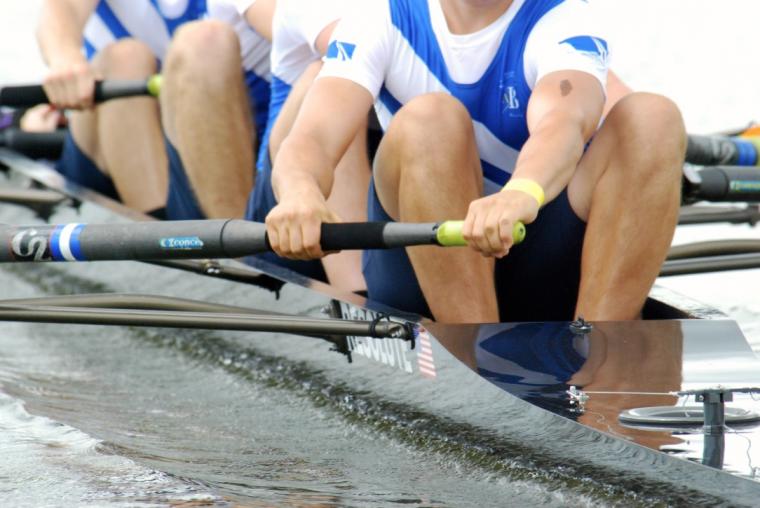
 www.usrowing.org
www.usrowing.org
USRowing is a nonprofit membership organization recognized by the United States Olympic Committee as the national governing body for the sport of rowing in the United States. USRowing selects, trains and manages the teams that represent the U.S. in international competition including the world championships, Pan American Games and Olympics. More than 75,000 individuals and 1,200 organizations strong, USRowing serves and promotes the sport on all levels of competition. USRowing membership reflects the spectrum of American rowers – juniors, collegians, masters and those who row for recreation, competition or fitness.
Sports Destination Management: Rowing is popular, and it’s bound to get even more visibility with the Olympics coming up. What kind of growth are you seeing?

SDM: What do you think has really spurred that kind of growth?
Dominique: For juniors, it’s really driven by the opportunity to go to college. One-third of all high school rowers will go on to college. That’s something that has really fueled interest from rowers and their parents. People see the sport as a doorway to the future.
SDM: With the Olympics on the horizon, what is USRowing doing to build awareness?
Dominique: We have the Row to Rio campaign going on now, which not only raises awareness but gets our local clubs involved with meet-ups, doing watch parties, events like that. We also have National Learn to Row Day at the beginning of June, which gives people the chance to try rowing at local clubs – or in health clubs on rowing machines.
SDM: Earlier, you mentioned the growth at the junior level. Is there rowing below the high school age group?
 Dominique: We are starting to see more middle school programs but those are still in the early developmental stages. We haven’t seen it as much on the national level. The biggest challenge would be the equipment, which is the same size as it is for high school and college; it’s hard for a kid that age to carry it and control it. There’s also a lot of attention to detail and discipline in the sport, and that’s a bit of a challenge when you’re talking about a 13- or 14-year old.
Dominique: We are starting to see more middle school programs but those are still in the early developmental stages. We haven’t seen it as much on the national level. The biggest challenge would be the equipment, which is the same size as it is for high school and college; it’s hard for a kid that age to carry it and control it. There’s also a lot of attention to detail and discipline in the sport, and that’s a bit of a challenge when you’re talking about a 13- or 14-year old.
In our long-term strategic planning, we talk about offering Under-15 programs, so it’s something we see as a growing area.
SDM: What is USRowing’s membership like?
Dominique: It’s an exciting time for the sport. We’re setting membership records. Our convention this past year had great attendance; I don’t know if it broke the record, but it was definitely one of the larger events.
SDM: USRowing also offers events for athletes with disabilities.
Dominique: USRowing has a Para-Rowing National Team that competes in the Paralympics and the World Championships. We also offer an adaptive rowing program and we can work with clubs if they want to start a program of their own. USRowing also partners with the Veterans Administration on a program called Freedom Rows, meant to get veterans active in the sport. Adaptive rowing is an area with potential for growth.
SDM: USRowing offers a number of events each year. How does it select its venues?
Dominique: It comes down to two main things: having the support of a local rowing club and having the facility. Our sport is pretty unique when it comes to venues. We need a body of water wide enough for six to seven racing lanes, and long enough for the course – 2,000 meters for a standard course, and 1,000 meters for a masters course. It needs to be protected from the wind and have as little current as possible. The next big challenge after that is the land access. An eight-man shell is 63 feet long, so you need roughly the same amount of space for each shell that you would use to park an 18-wheeler. There just aren’t too many places like that.
 We’re always looking for places to host, so we encourage people to keep an eye out. Once you have a place on the water, you look at other things. You want a city that isn’t too big so that the event doesn’t get lost, and you want a city with the amenities you need: easy access by land and by air, as well as the number and quality of hotel rooms.
We’re always looking for places to host, so we encourage people to keep an eye out. Once you have a place on the water, you look at other things. You want a city that isn’t too big so that the event doesn’t get lost, and you want a city with the amenities you need: easy access by land and by air, as well as the number and quality of hotel rooms.
We have different age groups competing in different events, and their needs are different when it comes to places they can stay. Our masters group, for example, uses a rowing event as a vacation. They’ll fill up the most expensive room blocks first. They might be coming for the racing but they’re staying for the social aspect. A lot of them have a high level of income and they want to be comfortable if they’re going to be in town for four days. It’s interesting how our different events have completely different personalities.
SDM: If a city is interested in hosting, or talking about hosting, who do they contact?
Dominique: They can speak to me, or they can investigate the bid process by looking at the section on our website. We can send people out to look at the city and see what they have. If people are interested in finding out if they have the right kind of place for a course, we recommend they get our rulebook which is available online. It has a guidance manual and best practices, and covers how a course should be laid out, as well as how you should set up an organizing committee.
SDM: If a city is interested in developing a venue, what do you recommend?
Dominique: We’re all about venue development. We don’t offer grants, but we can give consultation, and we can help advocate with local government to get funding. Aside from the fact that a new venue means growth on our end, it’s also a keystone sport for any city. A great example of this was Lowell, Massachusetts, which a number of years ago, was searching for tourism identity. They turned to sports and specifically to rowing, and they worked with us to develop a venue. They now host regional regattas and regional youth and masters championships, and were among the venues listed in the Boston bid for the 2024 summer Olympics. So you’re talking about a city that previously didn’t have a venue, and now hosts very viable events at the regional and national levels.
A lot of cities are renovating their riverfronts and waterfronts. Rowing is a great sport that can bring in solid economic impact dollars, and can allow cities to host big events with a great return on a relatively minimal investment. Any city out there that has a waterfront and is looking for opportunities can look into it. Plus, once you have rowing, you can host other sports. Dragon boating is one example, but there are plenty of others.
 SDM: What is it about rowing that makes it so popular on so many levels?
SDM: What is it about rowing that makes it so popular on so many levels?
Dominique: What’s great about the sport is it’s really appealing because you can practice and put in the time and learn how to be good at it. A person may not be the most athletic to begin with it; maybe they don’t have great hand/eye coordination or they can’t run the fastest, but anyone can sit in the boat follow the person in front of them. It’s a great opportunity to be part of a team without being in a typical team sport.

